Obstacle course
Navigating rainbows and other challenges in ‘Public Art’
The towering rainbow sculpture “Beyond the Rain” by Maia Hay ’20—installed on the path in front of Gebbie Hall on campus— was not supposed to be there. It was meant to be placed in a nearby Franklin, Mass., sculpture park months ago.
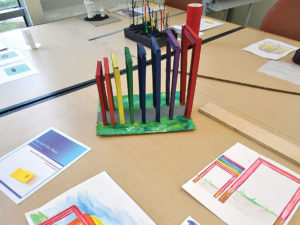
the Rain” awaiting review by a panel of judges.
But not everything in Professor Kelly Goff’s fall course “Public Art” went according to plan: The rainbow sculpture installation was delayed by a town permit issue and then had to wait for an inspection to ensure that it was safe to dig at its temporary installation site on campus; New England’s finicky weather and a semester-away commitment delayed and then prevented the final completion of another art piece on campus; and the police had to get involved to solve the case when one student’s art at the sculpture park was mysteriously removed due to a misunderstanding.
Indeed, there were many obstacles. But that made the course perfect for real-world learning: perfect for illustrating the power of public art in engaging those who interact with it—especially when those interactions spark conflict; perfect for experiencing the support of a team of 40 staff and faculty members who helped in various ways to make the course successful; perfect for teaching problem-solving in making what seems impossible possible (one student had to figure out how to stand on water to bring forth his creative vision); perfect for making beautiful, complicated, storied public sculptures across campus and beyond, as well as clarifying what putting work out in wide-open spaces for judgment and interpretation actually entails.
Here, we present (with great admiration) the work and comments from Goff as he walks us through the course.
—Sandy Coleman
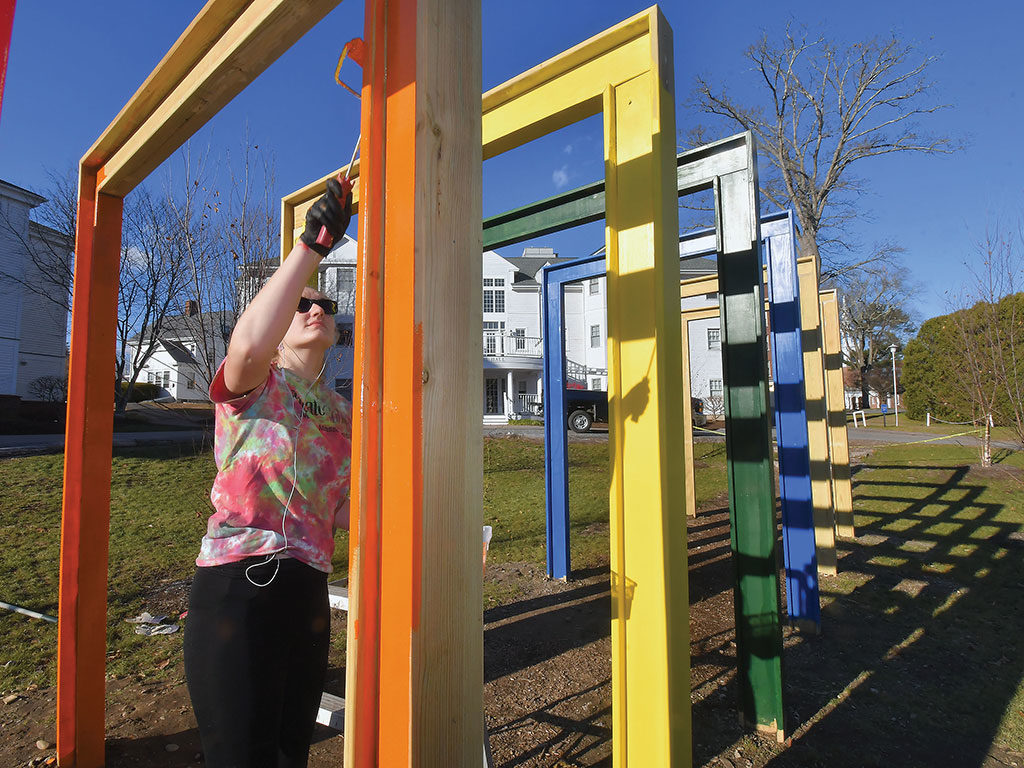
Risk and responsibility
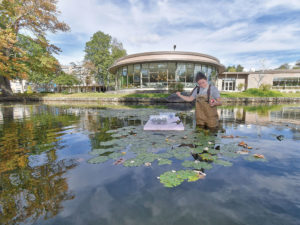
blossoms to lily pads for her “Public Art” project.
“The sharing of art is as important as the making of art. Public art, in particular, is an especially potent facilitator of conversations within communities. It has the power to unite people in collective expression, to reflect our times and to embody in symbols that could be subtle or overt, the personal, the political, the emotional and other meaningful sentiments. Conversely, public art is capable of offending, dividing and even physically harming persons and property. Therefore, our ambitious endeavor came with great responsibility. The course is designed to teach ways of engaging with the public and public space in ways that are researched, intentional, sensitive and aware. Participants in the course, including myself, acknowledged and embraced a big unknown—the question of how work would be received by the communities surrounding it. Students accepted the risk that their work could be damaged or stolen and that they might inadvertently upset or offend someone, and so they proceeded with both excitement and caution.”
—Kelly Goff, assistant professor of art
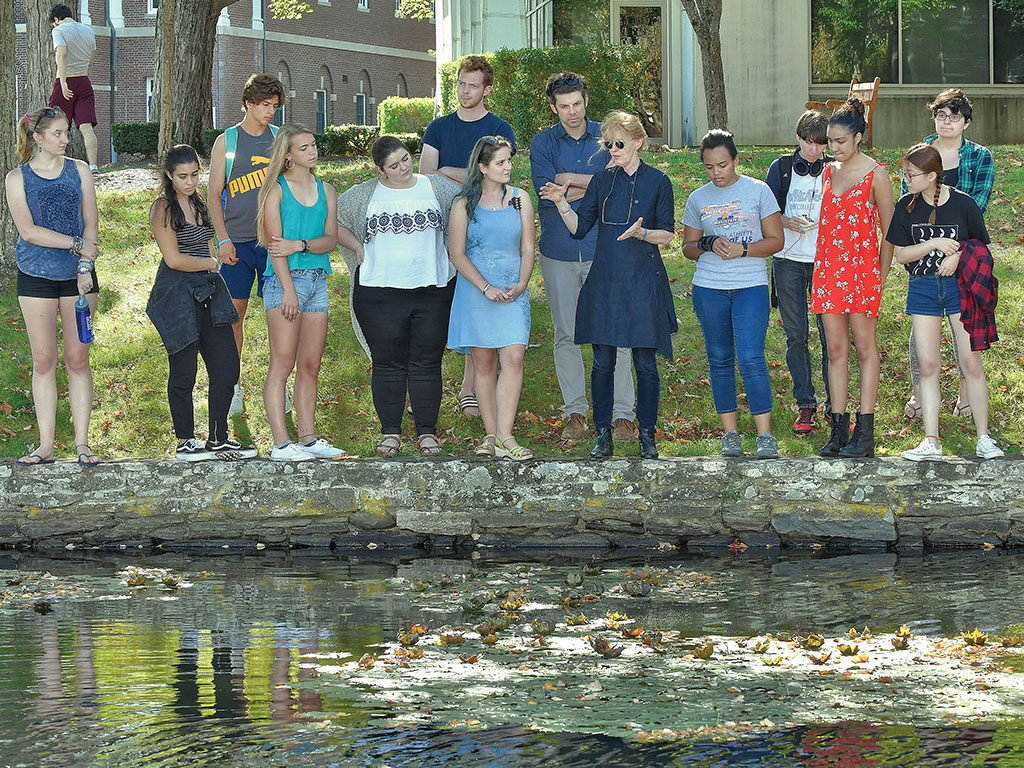
Proposals and professionalism
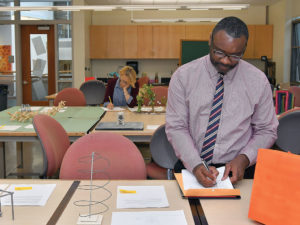
several judges to select projects for installation.
The central project of the course taught students how to prepare a professional quality public art proposal, complete with annotated drawings, artistic renderings in 2-D and 3-D models, project narrative and budget. The proposals were reviewed by a panel of professors (excluding Goff) and the director of Franklin’s sculpture park, who scored each proposal during several hours and selected winning works to be sited on campus and in Franklin. Students worked in teams with Goff to produce the semi-permanent work.
Conversations about controversy
Throughout the course, students looked at the practice of public art from many vantage points and through the lens of numerous historical works and the work of contemporary practitioners, Goff notes. “We examined a variety of related topics, like how artists receive funding for their work, which we discussed with Elizabeth Keithline, the interim director of Wheaton’s Beard and Weil Galleries, who also manages public art programs for the state of Rhode Island. We also discussed controversies in public art like the status of American Confederate monuments, which were being hotly discussed in the media, and we looked at ‘Fearless Girl,’ for example, the bronze statue that faces off with the iconic Wall Street sculpture ‘Charging Bull.’”
A network of support
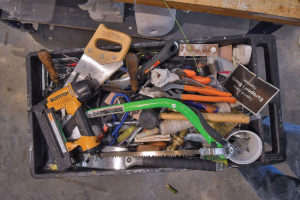
Many people not enrolled in the course participated. “It was the most logistically complicated course I’ve ever taught,” says Goff. “It not only involved the community as audience and participant in defining the artwork (as with interactive works) but also relied on the community to physically make it all happen. I sat down recently to draft a thank-you note to all the friends and colleagues who helped make the course possible. The list quickly grew to 40 people, including those who facilitated funding, logistical and administrative support, physical help, panelists, invited speakers, a visiting artist and those with expertise in insurance, public safety, environmental conservation, engineering and more.”
And every role played was much appreciated by the students. “It was amazing having visiting artist Ellen Driscoll come in and be there for our critique. It really gave me a different perspective that has helped me grow as an artist and think in ways I would not have before,” says Maia Hay. “To me, public art has always been something that can make a difference, even if only in one person’s life. If someone just looked at this project and thought how pretty it is and it made them smile, or if they sat on the bench to look at it and relaxed from the stress of the day, then my sculpture made a difference for them.”
A hard lesson
The first work to be installed in the sculpture park off-campus was vandalized. The work, titled “Leaving History,” which was produced by Charlotte Middleton ’18 with peer assistance, referred to Franklin town history and paid homage to Benjamin Franklin’s gift of 116 books to the town. The donation led to the founding of the first public library in America. Middleton’s ‘books’ were made of white weatherproof paper and were installed briefly in the trees in the park until someone misunderstood their purpose and disposed of the entire work. “The experience was upsetting for all, yet provided a valuable educational experience and a real-world illustration of some of the challenges associated with public art,” Goff says.
Challenge accepted
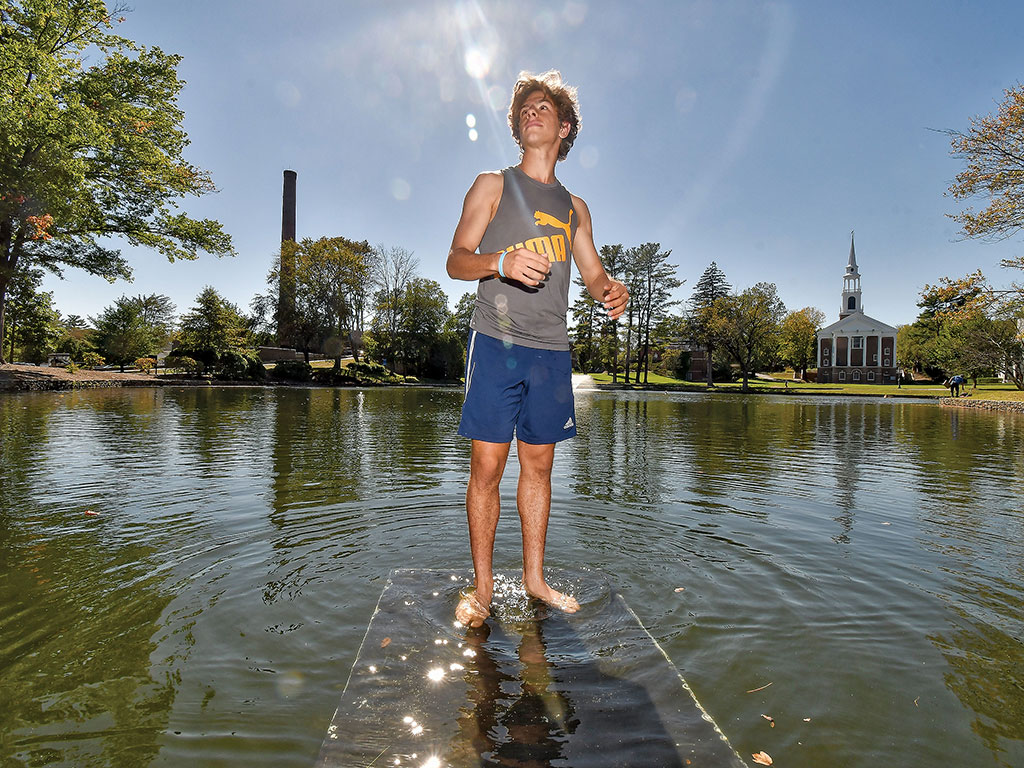
The group of students working on “Beyond the Rain” encountered unforeseen delays in installation permitting when it was discovered that the planned site is part of a protected wetland. “This setback allowed us to preview ‘Beyond the Rain’ by Maia Hay and ‘Trees of Life’ by Min Bae on the Wheaton campus this spring, while we worked diligently with the Franklin Conservation Commission and Department of Public Works to participate in their process. We now have approval and plan to install these works in the sculpture park soon,” Goff says.
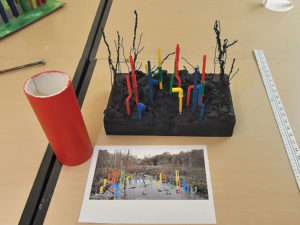
“Trees of Life” by Min Bae ’19
That makes Bae happy. She won a spot in the Franklin sculpture park for her colorful PVC pipe sculpture. “The idea of the ‘Trees of Life’ came into existence from the small wetland in the sculpture park,” says Bae. “The dying pond used to be a pool where swimming lessons were held. ‘Pool’ brought up the memories of modern pools and water park slides, and that is where the image of pipes, which conveys water, came from.”
Rising to meet a challenge of his own making was Nathan Domingos ’20, who created a submerged platform that one could stand on to appear to be walking on water. “I decided to sink my project into the water rather than make it visible, which caused it to become both a tactile and visual experience (you have to stand on it in order to fully experience the piece, because there is no visible structure),” says Domingos. “It makes the impossible proposition of walking on water possible. In doing this, I am trying to symbolically convey that the idea of the impossible is a matter of perspective.”
Team bench
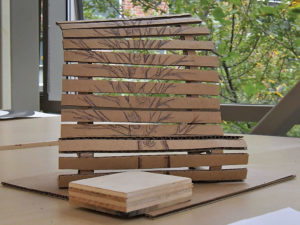
Coppinger ’20 with the burnished tree that still
needs to be completed on the real version
“Softwood Seat” was created by sociology and studio art double major Josephine “Jo-z” Coppinger ’20 as a functional bench and art sculpture designed to seat four people. It is the sculpture that she is most proud of because it was selected for funding and creation on campus.
She explains the effort that went into it: “The challenge of finishing ‘Softwood Seat’ was timing three busy college students’ schedules. Much of the work that the bench needed required everyone being there. My original proposal had a wood-burned tree in the design. However, the weather interfered with the timing and completing the design; it couldn’t be done in the snow. The bench was installed in fall 2017 and into the winter, and then I left second semester for the Semester in the City program. This made it difficult to find time to work on the bench while living in Boston. When I return to campus this fall, I plan to finish the design. … One lesson I took away from the class is the value of teamwork and division of labor to conquer a group project. In class, we worked in various groups a couple times to complete projects. Working together as artists can have major benefits for collaboration. However, depending on one’s compatibility, many challenges can also arise. The groups functioned differently throughout the class, and I certainly learned from success and failure in group work. I will carry the experience of working in groups with me to reflect on and remember to be flexible and assertive in the right moments.”
Full-blown collaboration
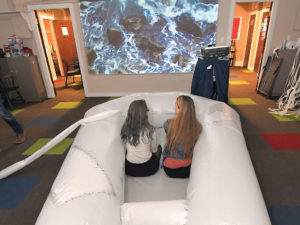
filled the chapel basement in November 2017.
Students in Goff’s ”Public Art” and Assistant Professor of Filmmaking Patrick Johnson’s “Production 1” courses teamed up to create a one-evening exhibition of multimedia artwork in the chapel basement meeting room in November 2017. Large-scale sculptures made of inflated plastic sheeting had original film content projected from within and onto their surfaces. The project was mainly about scale and collaboration. Sculptors primarily handled the large inflated structures and filmmakers were responsible for producing original content that was projected on the sculptures. Both components were produced within a 10-day window.